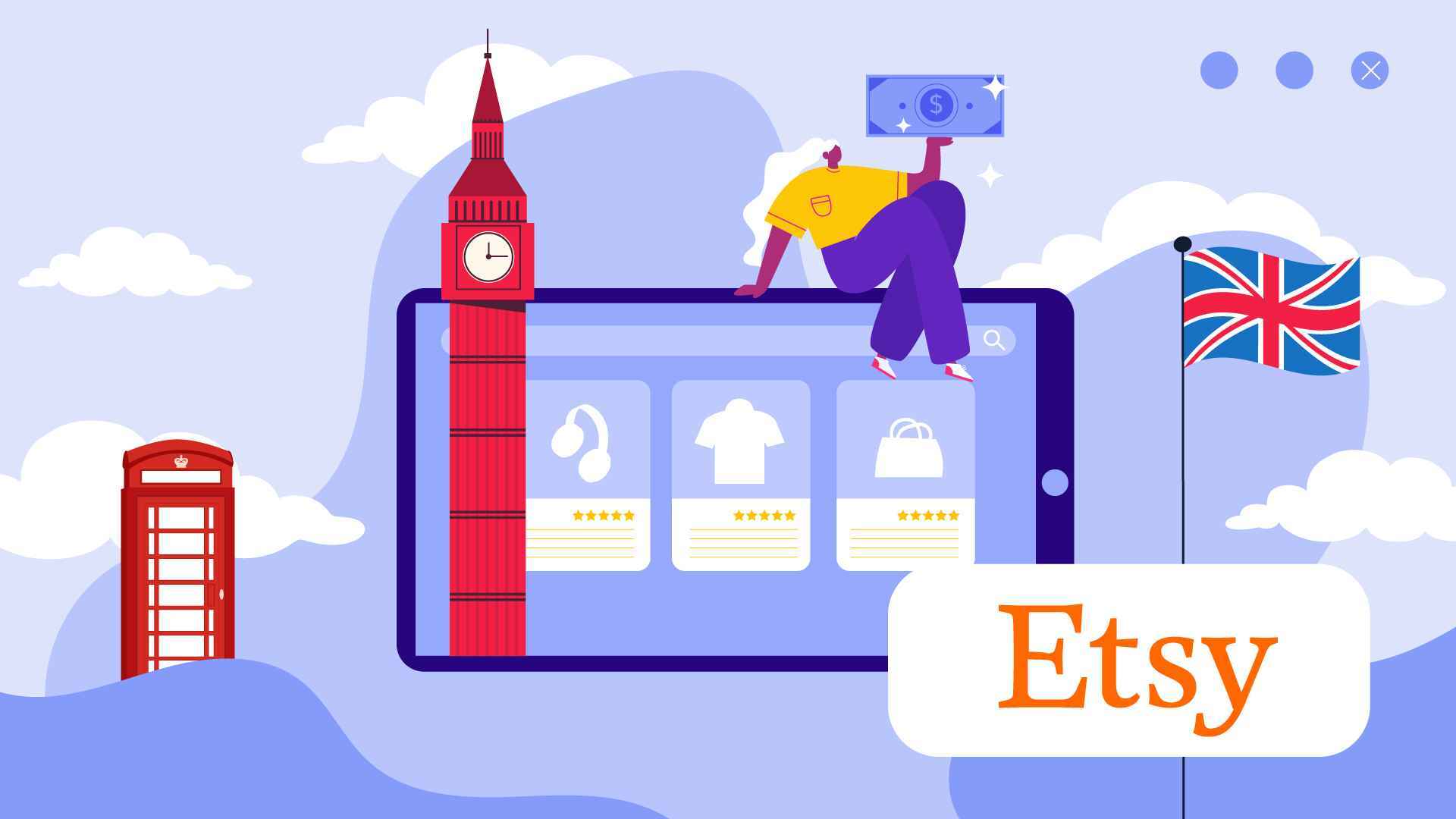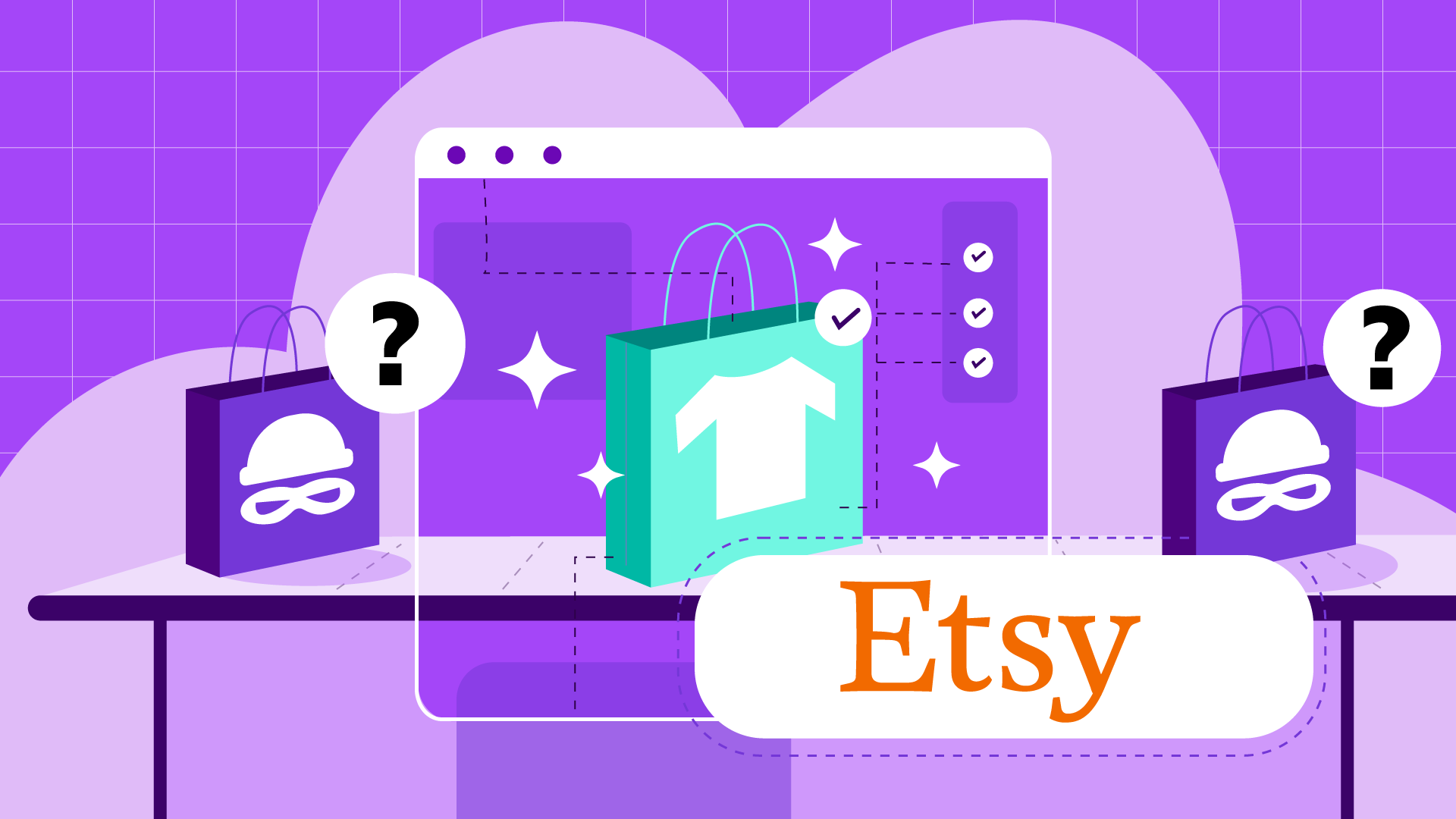Etsy has rapidly become a go-to platform for those looking to buy and sell unique, handcrafted, and vintage items. This article explores everything you need to know about selling on Etsy, from setting up your shop to maximising your sales.
This comprehensive guide will help you confidently navigate the Etsy marketplace.
Key Takeaways
-
Etsy's Unique Selling Proposition: Learn why Etsy stands out as a marketplace for handmade, vintage, and craft supplies.
-
How to Start Your Etsy Shop: Step-by-step guidance on setting up your shop, managing listings, and optimising your profile.
-
Understanding Etsy's Fee Structure: A breakdown of the fees associated with selling on Etsy UK.
-
Shipping and Payments Tips: Discover strategies for handling shipping and payments smoothly, ensuring a positive experience for you and your customers.
-
Maximising Sales with SEO and Marketing: Tips and tricks for optimising your listings and leveraging Etsy’s marketing tools to boost sales.
-
Streamlining Your Selling Process with Vendoo: Learn how Vendoo can simplify cross-listing and managing your Etsy shop, helping you save time and increase efficiency.
What is Etsy?
Etsy is a popular selling marketplace with approximately 97.3 million active users worldwide. With a constantly increasing number of sellers and shoppers, Etsy generates billions of pounds annually. It has a large audience and is a great place to buy and sell handmade goods, vintage items, and craft supplies. Etsy’s mission is “to keep human connection at the heart of commerce.” ❤️
👀 Did you know that Etsy acquired Depop in June 2021?
What Can You Sell on Etsy?
You can sell handmade items, vintage fashion, and craft supplies on Etsy. Handmade items are the top-selling category on Etsy. On Etsy, handmade goods are made by the seller, ranging from clothing to décour and everything in between (including digital downloads). Vintage items are at least 20 years old, for which you can provide age authentication. Craft supplies include tools, ingredients, and materials whose primary purpose is for use in the creation of an item or special occasion (including party supplies).
While I always recommend reading the terms of use for every selling platform, here is an introduction to selling on Etsy UK.
Etsy Seller Fees: How Much Does Etsy Charge?
Etsy UK has low seller fees- especially considering the seller’s freedom in shop policies, but many resellers are deterred by the listing fee (it’s not too bad at £0.16 per item...).
Etsy has a somewhat complicated fee structure with many types of fees involved:
Set-Up Fees
To open your Etsy shop, you may be required to pay a one-time, non-refundable set-up fee. The fee, if applicable, varies by region, and will be shown during the shop set-up process and charged after your shop is open and ready to receive orders. By providing card details and approving the fee, you authorise Etsy to charge your payment method.
The set-up fee may be waived during promotional periods and is subject to change at Etsy's discretion. Taxes may apply based on your location and will be reflected in your payment account, deducted from sales.
Listing Fees
Etsy’s listing fee is £0.16 per listing (which automatically renews and charges every four months by default, but you can disable that).
Transaction Fees
Transaction fees are the charges applied by Etsy for each completed sale on the marketplace. These standard commission fees are essentially the cost of using Etsy’s marketplace to reach potential buyers and are a crucial part of Etsy’s revenue model. Currently, Etsy UK charges a transaction fee of 6.5% on the sale price of each item. Remember that the sale price includes the cost of the item and applicable shipping, handling, and gift wrapping charges — 6.5% of that total.
Payment Processing Fees
Payment processing fees cover the costs of handling payments made through Etsy’s platform. These fees are applied to each order to facilitate secure and efficient transactions between buyers and sellers. For UK sellers, the standard payment processing fee is 4% plus £0.20 per transaction. These fees may vary depending on the payment method used by the buyer or the seller’s location. For example, international transactions may incur different processing fees due to varying banking regulations and processing costs.
Currency Conversion Fees
Currency conversion fees apply when a seller lists items in a different currency than the buyer’s, so this applies to some global transactions. These fees are incurred when Etsy converts the payment into the seller’s currency, allowing the funds to be deposited into their account. The currency conversion fee typically amounts to 2.5% of the total sale price. This fee is particularly relevant for sellers targeting international buyers, as it can impact the overall profitability of sales made in foreign currencies. Understanding these fees is essential for accurately pricing items and managing costs when selling internationally on Etsy.
Promotional Etsy Ad Fees
There is also an optional 15% off-site ad fee. If you choose to opt into an Etsy Ads Campaign, a 15% fee applies only when you make a sale as a direct result of the off-site ad.
Note that if your Etsy shop made £7,500 or more in the past 365 days, you'll be required to participate in Etsy Ads for the lifetime of your shop, and you’ll get a discounted advertising fee. If your Etsy shop made less than £7,500 in the past 365 days, Offsite Ads are optional. Learn more about Etsy Ad requirements here.
List, grow, and manage your inventory all in one place with Vendoo
How Do You Ship on Etsy UK?
Etsy puts the seller in control of all things shipping, including handling time, cost, geographical limitations, taxes, and shipping carriers, including Royal Mail, DHL, and Hermes. You can control these settings in custom shipping profiles in your Shop Manager.
Step-by-Step Guide to Selling on Etsy UK
Selling on Etsy can be lucrative, but it requires careful planning and execution. This step-by-step guide will walk you through the essential processes to set up and manage a successful Etsy shop.
You might also be interested in the article How to Flip in the UK.
1. Create an Etsy Account
The first step to selling on Etsy is creating an account. Sign up on the Etsy website or app by providing basic information such as your name, email address, bank information, payment methods, and password.
Once registered, set up a seller profile with a clear photo and a brief introduction about yourself or your business. This helps build trust with potential buyers.
💡 Tip: Make your shop bio personal. Etsy buyers love to shop from small businesses.
2. Set Up Your Etsy Shop
Next, it’s time to set up your Etsy shop. Choose a memorable and relevant shop name that reflects your brand. Set up shop preferences, including your shop’s location, currency, and the languages you’ll support.
Craft a well-thought-out shop description that tells your storey and explains what makes your products unique. Also, establish your shop policies, including shipping methods, return policies, and processing times, to set clear customer expectations.
💡 Tip: Etsy profiles allow you to create rules for shipping and returns that you can apply to your listings. Note that you can apply different profiles to different listings. Vendoo users can sync their Etsy Shipping Profiles with Vendoo!

3. Create Listings
Creating effective listings is crucial to attracting buyers. Start by taking high-quality photos of your products from multiple angles, ensuring the images accurately represent your items. Write detailed and engaging descriptions that highlight each product’s features and benefits. Don’t forget to select relevant tags and categories to help potential buyers find your listings through Etsy’s search features.
💡 Tip: SEO (search engine optimisation) is hugely important on Etsy. To learn how to maximise your descriptions, see the Guide to Keywords and SEO for Sellers.
4. Set Up Payment and Billing
You’ll need to set up your payment methods to start receiving payments. Link your bank account to your Etsy shop to enable deposits of your sales revenue. You’ll also need to provide billing information to cover any fees associated with your shop. Consider the payment options available, such as Etsy Payments, which allows buyers to pay using various methods like credit cards, PayPal, and more, thereby widening your customer base.
5. Customise Your Shop
Personalising your shop’s appearance is essential for creating a cohesive brand identity. Use Etsy’s customisation tools to add a logo, banner, and other branding elements that align with your shop’s aesthetic. A consistent visual identity helps make your shop more recognisable and appealing to customers.
6. Promote Your Shop
Marketing your Etsy shop is key to driving traffic and increasing sales. Leverage social media platforms to showcase your products and connect with potential buyers. Consider using Etsy Ads to boost the visibility of your listings within Etsy’s marketplace. Offering discounts, promotions, and special deals can attract customers and encourage repeat purchases.
7. Manage Orders
Once you start receiving orders, efficient management is crucial. Monitor your orders through your Etsy Dashboard and ensure timely communication with buyers to answer questions promptly. Handling shipping and returns promptly and professionally will enhance customer satisfaction and build a positive reputation for your shop. Positive reviews are important on Etsy, as they affect your shop’s promotion and listing visibility.
How Do Etsy Sellers Get Paid?
Getting paid on Etsy is quick and simple. When you are a brand new Etsy seller, you will be in a probationary period whereby your funds will not be available for deposit until a few days after a sale. On Etsy, you can set up a deposit schedule for funds or request your funds at any time. Either way, Etsy makes direct deposits to your bank account.
You may also like the article Alternatives to Etsy for Sellers.
Etsy Tips and Tricks: How to Make More Sales on Etsy UK
Maximising your sales on Etsy requires a strategic approach to how you list and market your products. By optimising various aspects of your shop and leveraging the right tools, you can significantly increase your visibility and attract more buyers. Here are some essential tips and tricks to help you boost your Etsy sales:
Crosslist with Vendoo
Etsy is a Vendoo marketplace, so you can easily crosslist your items directly to Etsy from Vendoo! Crosslisting allows you to reach a broader audience by making your products available on multiple marketplaces, increasing your chances of selling.
Vendoo simplifies this process by enabling you to manage your listings across various marketplaces from a single platform. By using Vendoo to crosslist your items on Etsy and other marketplaces, you can save time, reduce manual effort, and ultimately expand your reach to a wider customer base.
Use High-Quality Imagery
Like other reselling marketplaces, high-quality photographs are essential for standing out on Etsy. With so much competition, your product images need to capture attention and convey the quality and uniqueness of your items. Ensure that your thumbnail image (cover photo) is eye-catching, as it’s often the first thing potential buyers see. Additionally, consider incorporating video content to showcase your products in greater detail, which can further enhance their appeal.
💡 Tip: According to Etsy, listings with videos get twice as many orders as those without them!
Craft Effective SEO-Optimised Descriptions
Effective descriptions are crucial on Etsy, as they inform potential buyers about your products and play a key role in search engine optimisation (SEO). To maximise your listings' visibility, use relevant keywords throughout your descriptions and carefully select tags, categories, and attributes that accurately describe your products.
By optimising your descriptions and hashtags, you can ensure that your products appear in relevant search results, thereby attracting more potential buyers.
Execute Etsy Item Attributes
Etsy offers many “optional” listing fields in your item details. Treat these fields as mandatory for best results and execute them fully to enhance your exposure. Many attribute fields are also search filters; if you fail to execute them, you’re eliminating your listings from potential buyer searches.
💡 Tip: If you are selling personalised items made to order, a few other steps are involved in the listing process.
Set Competitive Prices
The competition is stiff on Etsy. Offering competitive pricing is one of the most effective ways to attract buyers on Etsy. Research market prices for similar items and adjust your pricing to stay competitive. Additionally, consider how your shipping costs impact the overall price of your product. Offering low or free shipping can make your listings more appealing and increase your chances of selling. Balancing your pricing with shipping costs is key to remaining attractive to buyers while maintaining profitability.
Enhance Your Etsy Shop Profile
Etsy recommends optimising your shop profile with strong branding and a professional appearance. A well-branded shop profile makes your shop more visually appealing and builds trust with potential buyers. Take advantage of the tools and resources available to enhance your shop's appearance, such as customising your shop banner, logo, and other visual elements. A cohesive and professional shop profile can help establish your brand identity and make your shop stand out in a crowded marketplace.
Engage with Customers
Engaging with your customers is vital on Etsy, especially given the platform’s focus on niche, personalised goods. Building relationships with your buyers can lead to repeat business and a loyal customer base. Respond promptly to enquiries from potential customers, offer personalised service, and go the extra mile to make your buyers feel valued. Encouraging customer engagement enhances the shopping experience and increases the likelihood of receiving positive reviews, which can further boost your shop’s reputation.
Upgrade to Etsy Plus
Consider an Etsy Plus subscription once you’re comfortable selling on Etsy and ready to take your shop to the next level. Etsy Plus users benefit from customisable shop options, customer alerts, a website domain, bonus listings, and advertising credits. These features can help you further enhance your shop’s appearance, increase your visibility, and ultimately boost your sales.
Boost Your Etsy Store with Vendoo
As we've discussed throughout this article, setting up and growing a successful Etsy store involves several key steps: from creating a compelling shop profile and listing high-quality items to optimising your listings for SEO and engaging with potential customers. These strategies are essential to standing out in the competitive Etsy marketplace and maximising your sales potential.
One of the most powerful tools to help you streamline this process and manage your inventory across multiple platforms is Vendoo. By using Vendoo, you can effortlessly cross-list your items on Etsy and other marketplaces, reaching a broader audience and increasing your chances of making sales.
Vendoo helps you save time and enhances your ability to scale your business efficiently. With Vendoo, you can manage your inventory seamlessly, ensuring that your products are always up-to-date across all marketplaces.
If you want to boost your Etsy store and maximise your selling potential, I highly encourage you to try Vendoo. It’s the perfect companion for any Etsy seller looking to enhance their selling experience and achieve greater success on Etsy and beyond.
Start enhancing your Etsy selling experience with Vendoo today!
Do you sell on Etsy? Please share some of your best Etsy tips and tricks below! 👇







